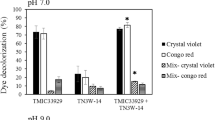Abstract
The effect of co-culturing white-rot fungus Phlebia brevispora with growth-promoting bacterial strains Enterobacter sp. TN3W-14 and Pseudomonas sp. TN3W-8 on the degradation of polycyclic aromatic hydrocarbons (PAHs) was evaluated in liquid culture. In axenic cultures, P. brevispora strains TN3F and TMIC33929 showed high degradation of phenanthrene (> 98%) within 15 days, and degraded 65% and 63% of pyrene, and 12% and 8% of benzo(a)pyrene, respectively. This low level of degradation ability toward benzo(a)pyrene was improved significantly by co-culturing the fungi with a mixture of bacterial strains TN3W-8 and TN3W-14 (mixed bacterial co-culture; MBC). Within 15 days, P. brevispora TN3F with MBC achieved about 86% pyrene and 53% benzo(a)pyrene degradation; P. brevispora TMIC33929 with MBC showed 92% pyrene and 72% benzo(a)pyrene degradation. The MBC alone degraded little PAH, as its growth was inhibited by PAH; however, its co-culture with P. brevispora improved mycelial growth of the fungus, which led to improved degradation of the PAHs. A possible dihydrodiol metabolite of pyrene from fungal cultures suggests that hydroxylation was the first step in the degradation of pyrene by P. brevispora.




Similar content being viewed by others
References
Boonchan S, Britz ML, Stanley GA (2000) Degradation and mineralization of high-molecular-weight polycyclic aromatic hydrocarbons by defined fungal-bacterial cocultures. Appl Environ Microbiol 66:1007–1019
Bouchez M, Blanchet D, Vandecasteele JP (1995) Degradation of polycyclic aromatic hydrocarbons by pure strains and by defined strain associations: inhibition phenomena and cometabolism. Appl Microbiol Biotechnol 43:156–164
Buswell JA (1991) Fungal degradation of lignin. In: Arora K, Mukerij KG, Knudsen G (eds) Handbook of applied mycology. Marcel Dekker, New York, pp 425–480
Cerniglia CE (1997) Fungal metabolism of polycyclic aromatic hydrocarbons: past, present and future applications in bioremediation. J Ind Microbiol Biotechnol 19(5–6):324–333
Gibson DT, Mahadevan V, Jerina DM, Yagi H, Yeh HJC (1975) Oxidation of the carcinogens benzo[a]pyrene and benzo[a]anthracene to dihydrodiols by a bacterium. Science 189(4199):295–297
Haritash AK, Kaushik CP (2009) Biodegradation aspects of polycyclic aromatic hydrocarbons (PAHs): a review. J Hazard Mater 169(1–3):1–15
Harry-asobara JL, Kamei I (2018) Bacterial strains isolated from Cedar wood improve the mycelial growth and morphology of white rot fungus Phlebia brevispora on agar and liquid medium. J Wood Sci 64(4):444–450
Heitkamp MA, Freeman JP, Miller DW, Cerniglia CE (1988) Pyrene-degradation by a Mycobacterium sp.: identification of ring oxidation and ring fission products. Appl Environ Microbiol 54(10):2556–2565
Hiraishi A (1992) Direct automated sequencing of 16S rDNA amplified by polymerase chain reaction from bacterial cultures without DNA purification. Lett Appl Microbiol 15(5):210–213
Johnsen AR, Wick LY, Harms H (2005) Principles of microbial PAH-degradation in soil. Environ Pollut 133(1):71–84
Juhasz AL, Britz ML, Stanley GA (1996) Degradation of high molecular weight polycyclic aromatic hydrocarbons by Pseudomonas cepacia. Biotechnol Lett 18(5):577–582
Juhasz AL, Britz ML, Stanley GA (1997) Degradation of fluoranthene, pyrene, benzo[a]anthracene and dibenz[a, h]anthracene by Burkholderia cepacia. J Appl Microbiol 83(2):189–198
Kamei I (2017) Co-culturing effects of coexisting bacteria on wood degradation by Trametes versicolor. Curr Microbiol 74(1):125–131
Kamei I, Suhara H, Kondo R (2005) Phylogenetical approach to isolation of white-rot fungus capable of degrading polychlorinated dibenzo-p-dioxin. Appl Microbiol Biotechnol 69(3):358–366
Kamei I, Sonoki S, Haraguchi K, Kondo R (2006) Fungal bioconversion of toxic polychlorinated biphenyls by white-rot fungus P. brevispora. Appl Microbiol Biotechnol 73(4):932–940
Kamei I, Yoshida T, Enami D, Meguro S (2012) Coexisting Curtobacterium bacterium promotes growth of white-rot fungus Stereum sp. Curr Microbiol 64(2):173–178
Kästner M, Breuer-Jammali M, Mahro B (1994) Enumeration and characterization of the soil microflora from hydrocarbon- contaminated soil sites able to mineralize polycyclic aromatic hydrocarbons (PAH). Appl Microbiol Biotechnol 41:267–273
Kim YM, Ahn CK, Woo SH, Jung GY, Park JM (2009) Synergic degradation of phenanthrene by consortia of newly isolated bacterial strains. J Biotechnol 144(4):293–298
Kotterman MJJ, Vis EH, Field JA (1998) Successive mineralization and detoxification of benzo[a]pyrene by the white rot fungus Bjerkandera sp. strain BOS55 and indigenous microflora. Appl Environ Microbiol 64(8):2853–2858
Meulenberg R, Rijnaarts HHM, Doddema HJ, Field JA (1997) Partially oxidized polycyclic aromatic hydrocarbons show an increased bioavailability and biodegradability. FEMS Microbiol Lett 15(1):245–249
Pino N, Peñuela G (2011) Simultaneous degradation of the pesticides methyl parathion and chlorpyrifos by an isolated bacterial consortium from a contaminated site. Int Biodeterior Biodegrad 65(6):827–831
Sutherland JB (1992) Detoxification of polycyclic aromatic hydrocarbons by fungi. J Ind Microbiol 9(1):53–61
Tortella GR, Diez MC, Duran N (2005) Fungal diversity and use in decomposition of environmental pollutants. Crit Rev Microbiol 31(4):197–212
Walter U, Beyer M, Klein J, Rehm HJ (1991) Degradation of pyrene by Rhodococcus sp. UW1. Appl Microbiol Biotechnol 34(5):671–676
Wang W, Yan L, Cui Z, Gao Y, Wang Y, Jing R (2011) Characterization of a microbial consortium capable of degrading lignocellulose. Bioresour Technol 102(19):9321–9324
Xiao P, Mori T, Kamei I, Kondo R (2011) Metabolism of organochlorine pesticide heptachlor and its metabolite heptachlor epoxide by white rot fungi belonging to genus Phlebia. FEMS Microbiol Lett 314(2):140–146
Acknowledgements
This work was supported in part by Grants-in-Aid for Scientific Research from the Ministry of Education, Culture, Sports, Science and Technology of Japan (Grant Nos. 18H02257 and 17K19296). We thank Edanz Group (www.edanzediting.com/ac) for editing a draft of this manuscript.
Author information
Authors and Affiliations
Corresponding author
Ethics declarations
Conflict of interest
The authors declare no conflict of interest.
Rights and permissions
About this article
Cite this article
Harry-asobara, J.L., Kamei, I. Growth management of white-rot fungus Phlebia brevispora improved degradation of high-molecular-weight polycyclic aromatic hydrocarbons. 3 Biotech 9, 403 (2019). https://doi.org/10.1007/s13205-019-1932-0
Received:
Accepted:
Published:
DOI: https://doi.org/10.1007/s13205-019-1932-0




